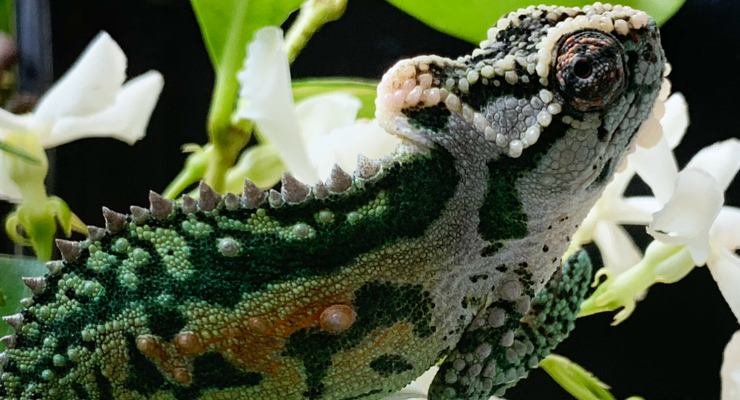Ep 119: Are Chameleons Good Pets?

It is easy to be smitten by chameleons. From their colors, horns, tongue, color change, and….just all of what they are, they are truly other-worldly and have a quick charm about them. Their popularity continues to grow through movie appearances and social media exposure. In addition, a growing community of breeders has made robust, captive bred chameleons easily available. But do they make good pets? Today we will discuss what kind of pets chameleons are.
Transcript (more or less):
I just got back from one of the west coast’s largest reptile shows. And I saw some examples of how our reptile community is improving when it comes to chameleons and how we still have far to go. But there is one trend that is greatly encouraging. In my time at the show talking to people about chameleons, I ran into a much higher number of people there doing research for a future purchase. This is wonderful! Not only are they researching chameleons, but they are researching who they should talk to and who will give the best advice! They are willing to spend the money for the right equipment upfront. All you experienced chameleon keepers know the truth – chameleon keeping is almost – dare I say, easy – when you set yourself up right from the beginning. Just think of most of the problems we spend our days solving on social media. Wrong husbandry advice. Inadequate equipment. Missing equipment. How many problems do we have to solve with someone who has a proper cage, lighting system, misting system, and supplementation? Not much at all! This show, though, I did much more discussion with people who were taking their research to a step before that. They were wondering if a chameleon was right for them in the first place. Wow. Now there is some insight. When you step outside of what you want and consider what is best for the animal you are bringing into your life you are doing it right. You need to make sure you are able to properly care of this creature and that your expectations are something a chameleon can fulfill.
Now many of you listening are long time listeners and are already passed this question. But once people learn you have a chameleon you are likely going to run into this question from them so let’s put our experience into words. I will be directing this podcast to speak to the ones that have been linked here and are asking this question for the first time.
So let’s dive in and ask the question – do chameleons make good pets? I am going to start off by saying that that depends on what we want with bringing another living being into our homes. There are many reasons why we bring animals close to us. Some are for companionship such as dogs and cats, some are for helping with work such as protection or herding sheep, and you could go on and on. Each animal has a certain personality make up that makes them suited for certain roles, and, by the same token, unsuited for other roles. Today’s discussion will focus on what is the personality make up of chameleons, what role can they play, and what role can’t they play.
I’d like to start by stepping back and exploring expectations surrounding any sort of pet. We usually think of a pet as form of companionship.
As you have heard on this podcast before, the best pets for companionship, and this means touch, cuddling, and sharing excitement and sorrow are the animals that feel those same emotions and have the same understanding of what touch means. Dogs are man’s best friend because they form social groups that are structured in both respect for authority and affection for pack mates. They play with each other. They feel excitement and they feel sorrow. It isn’t much work for them to accept that we are just ugly dogs with less fur and hands that can open containers with treats in them. Cats have a looser take on social structure and respect for authority, but it is still well within the circle of what we understand. Parrots are further out, but have such strong bonds with their flock members that they can imprint that on humans and become incredibly affectionate family members. Although it is interesting to note that much of the problems with parrots is they have a very strong bond with their flock mates and being kept in a cage with alone time is depressing for them. If you get a parrot you better have done your research into what a parrot needs for emotional health from you as their flock and be prepared for an endless need for attention – especially if you fall in love with a cockatoo. They will self-mutilate if isolated. So even though they have plenty of social structure elements that we do, we still have to acknowledge the differences. The further we get into the animal world the more foreign the social structure. And if we are going to take an animal out of its natural environment and make them part of ours, it is incumbent upon us to adjust to their social structure instead of assuming they will adjust to ours. So let’s review what a chameleon is and if we bring one into our home, what role in the social structure do we play?
Let’s start at the beginning. Upon birth, chameleons scatter. Whether digging their way out of the ground or being birthed live, the baby’s first instinct is to disperse and do their best to eat and not be eaten so they can grow up and reproduce. The significance with this is that they have no family concept. There is no benevolent being bringing food and offering protection. So the concepts we humans have as far as love and nurturing when we are children is completely foreign and non-existent to them. They grow up aware of other chameleons as family members or teammates. Other chameleons are competition and only have interaction value when it comes to mating later in life. Until then, others are just more mouths to share resources with. During all of this there is no such thing as nurturing or bonding with other chameleons. So we need to realize that our idea of touch equating to affection has no equivalent in a chameleon’s life. Except when fighting for territory or mates, they spend their lives hunting for food and hiding from predators. This is important because they still do that when we bring them into our homes. In one of my videos I said “if you want to make your chameleon happy, walk by his cage and pretend you didn’t see him.” This is the kind of pet a chameleon is!
So, can we really consider them pets? By the strict definition of the word, yes, but not if your definition of a pet expects they will have a concept or expression of love or bonding. There is comfort and trust, but beyond that is only delusional humans projecting emotions onto them.
Our biggest miscommunication is in touch. We use touch to explore the world and we hold what we love. Chameleons view touch with soon being a meal. When you touch or pet a chameleon the usual response is for the chameleon to rear back and lift its forearm in defense. Touch is a comfort to many animals – especially ones that nurture and raise up their young. The only thing that touches a chameleon as they grow up are animals trying to eat them or other chameleons chasing them away with a bite. So we have to be understanding of where our chameleons are coming from and recognize that we are the ones that will have to adjust to their needs, not them adjusting to our wants.
Okay, enough of this listing what a chameleon isn’t and warning us that we won’t get a cuddle toy or wise sage whispering in our ear. What kind of pet IS a chameleon and if they aren’t going to fetch the newspaper, why are there so many people enthralled with this creature?
What Kind of Pet is a Chameleon?
I think the best way to think about a chameleon is like a fish. We create a world that they live in, we maintain the world, and then we enjoy having this slice of nature in our homes.
A pet chameleon is very much a natural piece of art. They are more something to be watched than something to be held and played with. This is the first thing a new keeper must accept. You will always see some keepers bragging about how tame their chameleons are and how they love to be out. There are some exceptional chameleons that seem to have no problem with humans. This is on the normal scale of personality variation. But you can’t expect this or else you will most likely be disappointed.
Even captive hatched and raised chameleons retain much of their wild instincts that say that anything bigger than they are (that would be you) will probably eat them. Chameleons are intelligent and we can tame them down. But the most we can hope for when we say “tame” is that they tolerate us and will eat out of our hands. As I said, exceptional chameleons are out there that are just plain friendly, but they are rare and you don’t want to set yourself for disappointment by expecting your chameleon to “love” you.
A chameleon really doesn’t do much. They are content to sit and watch the world go by. They will move to their heat lamp in the morning then to their breakfast bowl for the morning meal. They then slink into their foliage to wait until something else happens. Though this life sounds incredibly boring to us remember that chameleons consider their day a win if they did not get eaten! Do not worry about your chameleon getting bored!
You may now be wondering why there are so many dedicated chameleon keepers for a pet that is, at best, tolerant of our presence. The answer is that we are fascinated with the world of the chameleon. The chameleon world is not for everyone and there are definitely reptiles that are much better at human interaction! If you are looking for a fun pet reptile then a chameleon may not be the right choice. If you are looking for a chameleon and nothing else will do then you are among friends here. If someone asks if they should get a chameleon I usually say no and see if they press. Considering the amount of work and expense that goes into keeping a chameleon I am waiting for the person that is so enthralled with chameleons that they cannot imagine not having one. And this is not an elitist test for those worthy to join the secret fraternity. This is a recognition that the only person that will enjoy what a chameleon is is one that is motivated, through fascination, to research deeply into what a chameleon is and how to create an environment that that chameleon will thrive in. It is not that keeping a chameleon is hard. Quite the contrary – there is so much good information, qualified mentors, and top notch products available that anyone who is motivated will have all the elements necessary to be successful. Heck, just a couple weeks listening to previous episodes of this podcast during your commute to work will give you more than enough information to make it work. But you have to be willing to put in that effort for research. The bottom line is that recreating a forest edge environment to mimic a tree 6 feet off the ground in a living room cage is not intuitive. So there isn’t a short cut.
Wait a minute, you say. The guy at the reptile show said all I needed was this little screen cage and a branch inside with this real cool dual bulb light fixture. That doesn’t sound like a whole lot of research! Nope, doesn’t take a whole lot of research for them to take your money and hope your chameleon lives past whatever warranty they may or probably do not offer. There are now 119 podcast episodes on chameleons in just this podcast. I have the rest of season four blocked out and season five is almost filled. You do not need to know everything that is in these podcasts to be successful with your chameleon, but you do need a great deal of it. If you want to bring a chameleon into your life you will become a researcher. You will be introduced to a completely different world view and you will be growing every month as you begin to better understand it. If you are just now considering whether you want a chameleon or not then the question stands – are you fascinated enough to enjoy learning new things? If you have already bought a chameleon based on advice that implied this all was simple then the question is– are you willing to essentially start over and relearn quickly?
A chameleon is the kind of pet that becomes a research project very quickly as you learn about UVB lights, supplementation, feeder insects, hydration strategies, and the list goes on and on…
In summary, a chameleon is more of a pet to watch and care for rather than one to interact with. The successful keepers are researchers that are looking for ways they can better provide a natural environment. The ones that fail are forcing their chameleon to come out and play and adjust to the human life.
Initial Set-up Costs
Your initial set-up costs are important. You must be prepared to spend the money upfront to get the right set-up. This will include a cage, misting system, UVB lighting system, and a captive born chameleon. (Notice I am not even considering a wild caught chameleon for you). You can budget anything from $300 to $1500 depending on your desires for function vs. quality and species. But work it out ahead of time and be ready with the costs. In next week’s podcast I will dive into initial set-up costs for a chameleon and apply real numbers to real products and we will hammer this out together.
How Life Changes
Let’s get on to how your life will change with a chameleon. Not only do we have to ensure our mind is in the right place, but that our lifestyle works.
Live Insects as Chameleon Food
Food first. Chameleons eat live insects so are you up for crickets that jump and chirp, superworms that may nip you, encouraging flies to come around, and keeping anything that has the name “roach”? Make sure that live insects will fit into your life. These insects must not only be alive, but nutritious. This means that you are not just dumping bugs from the pet store in the cage, but that you are keeping insects for 48 hours. Not only are you keeping insects, but you are feeding them and making sure they have the best care. You will have to be comfortable around insects.
This means you personally, your family members – especially if someone else is paying the mortgage or rent, and the owners of the property.
If you are the type that is fascinated by a chameleon, chances are that you will soon develop a fascination for the insect world. It turns out they are just as amazing as your chameleon and many of us end up breeding them under the guise of saving money on buying feeder insects. But, somehow, they never make it to the chameleon cage!
My wife went from screeching every time a cricket jumped or superworm pinched her finger to now being a insect breeder. She also went from just tolerating all these chameleons hanging out to building her own gecko breeding group for fun. So change does happen! But be aware that it doesn’t happen immediately and make sure you have a plan for the insects soon to be in your life. Take stock of the situation around you and make sure live insects will work.
Maintenance
And, of course, you need to make sure you have the time and money for maintenance. Maintenance for a chameleon consists of cleaning the cage, caring for the feeders, and keeping the hydration source filled. How long this takes depends on your initial set-up. Mostly in the hydration. Buying an automatic misting system is the one biggest time saver. Other than that, taking care of the insects requires more time than the chameleon! You have spot cleaning of picking up a non-smelling poop that probably has dried out around every other day. You make sure the water reservoir is filled and the automatic light and misting systems are functioning. Then it is just watching chameleon body language to see if they need anything more.
Costs can add up. You are buying feeder insects and supplements, saving up for a vet visit if necessary, and replacing UVB lights every 6 to 12 months depending on manufacturer. The insects are really the biggest monetary expenditure. If you get them shipped the shipping is not kind.
I want you to also consider your house environment. Many homes do not have air conditioning. How will you keep your home in the proper temperature range during the summer? Heating is more simple as a basking bulb is effective. But cooling is another matter. Most common chameleon species are comfortable in the 70s F. Low 80s will be okay, but get into the high 80s and 90s and there is no escape. Do you live in a house where you are forbidden to use the air conditioning or set it in the 70s? Because that would be trouble that you need to consider!
Other Pets
Speaking of trouble. – other pets! If you already have other pets you’ll need to do some planning as to where your chameleon cage will be. Chameleons will not like the animals we humans often keep around us. Dogs, cats, Parrots, and little kids are all potential predators and will stress your chameleon if they are in visual range.
You will need to arrange things so that cats cannot climb onto the cage and nap there. Dogs are easier as they usually are just running back and forth on the ground. Chameleons may be able to totally ignore these fur things rummaging about if the chameleon’s cage and highest perch are paced far above the action. Birds are a natural chameleon predator so the chameleon should not be able to see any pet bird larger than itself. The simplest approach is to ensure that current pets are not able to be seen by your chameleon.
A special note is that chameleons will not get lonely. Putting two chameleons together in a cage is not a good idea. Pet stores and reptile show vendors often try to sell chameleons as pairs and say they can be kept together. This is simply not true.
Kids
I am sure that many people listening to this are parents deciding whether it is a good idea to give in to their kid’s request to get a chameleon. And that is an individual decision based on what you know about your child. My universal answer to this question that has stood the test of time for many years is that chameleons are a great pet for parents with children who will learn responsibility by watching how their parents take care of the chameleon. Chameleons are a horrible pet for a child to take care of. Don’t get your kid a chameleon. Get yourself a chameleon so you and your kid can enjoy bonding while learning about it. Chameleons are not forgiving of neglect.
Who would be the perfect chameleon keeping candidate?
Chameleons are a link back to nature. The perfect chameleon keeping candidate will be one that is wanting to recreate a chameleon environment so they can bring out as many natural chameleon behaviors as possible rather than force a chameleon to adjust to the human world. Chameleons do best with keepers that are content to keep a distance and watch. Chameleons will require a great deal of attention, but none of it will be appreciated! You need to be okay with that! You will spend much time learning about this gentle mini tree dragon. Your reward will be an amazing insight into this world. Everything is connected. To understand chameleons we must understand the world we share with them.
So, what are chameleons like as pets? They are a window to another world. And that is more the necessary mindset than it is poetry. They have to be seen as something alien that we are getting to know. They sit in their cage hoping that no one finds them, but still feeds them. So they really aren’t that great as an emotional pet to be cuddled. But as an intellectual pet that is meant to stimulate your mind and imagination they are, in my opinion, unmatched.
Where do we go from here? You have some thinking to do. Chameleons are a more demanding reptile than others. It is expensive to set them up and they require a great deal of attention to detail. If you are looking just for a cool reptile I suggest you avoid chameleons. Although certainly cool, they are not for the casual interest. Get a chameleon if only a chameleon will do. That is how I got into chameleons. There just was no other option in my mind and I was willing to do what it took to have them around me. If you still are not sure, listen to some other podcast episodes that sound interesting and you’ll get a better feel for what this chameleon thing entails. Lurk on some social media sites dedicated to chameleons. I have been known to frequent a Facebook group called “The Chameleon Enthusiasts”. Check out www.chameleonforums.com and just look around at the conversations. If this all seems like it is too much then it is probably best to pass this one up. If what you hear and read excites you even more then it sounds like you are a good candidate to care for a chameleon!











